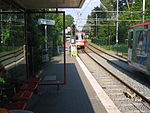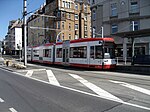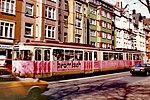| Dortmund Stadtbahn | |||
|---|---|---|---|
 | |||
| Overview | |||
| Locale | Dortmund and Lünen, North Rhine-Westphalia, Germany | ||
| Transit type | Light Rail (Stadtbahn) | ||
| Number of lines | 8 | ||
| Number of stations | 82 [1] | ||
| Website | |||
| Operation | |||
| Began operation | 1 June 1881 (tram) 15 May 1976 (light rail) | ||
| Ended operation | 26 April 2008 (tram) | ||
| Operator(s) | Dortmunder Stadtwerke AG (DSW21) | ||
| Number of vehicles | 126 (B6: 43, B8: 21, B100S: 8, NGT8: 47, B80D: 7) | ||
| Train length | 28 meters (min) 84 meters (max) | ||
| Technical | |||
| System length | 75.0 km (46.6 mi) [2] | ||
| Track gauge | 1,435 mm (4 ft 8+1⁄2 in) standard gauge | ||
| Electrification | 750 V DC Overhead line | ||
| Top speed | 80 km/h | ||
| |||
You can help expand this article with text translated from the corresponding article in German. (August 2020)Click [show] for important translation instructions.
|
The Dortmund Stadtbahn is a light rail system in the German city of Dortmund and is integrated in the Rhine-Ruhr Stadtbahn network. Its network consists of eight lines and is operated by Dortmunder Stadtwerke, which is operating under the brand DSW21 since 2005.
Contents
The light rail system was gradually opened between 1976 and 2008 by relocating the inner-city tram tracks in underground tunnels and opening new express tram routes that are independent of road traffic (e.g. Kirchderne – Grevel). It operates on 75.0 kilometres (46.6 mi) of route (of which 20.5 kilometres (12.7 mi) are underground in tunnels, with the other 54.5 kilometres (33.9 mi) being above-ground in dedicated rights-of-way). [2] It has 23 underground stations and 59 on the surface. [1]







